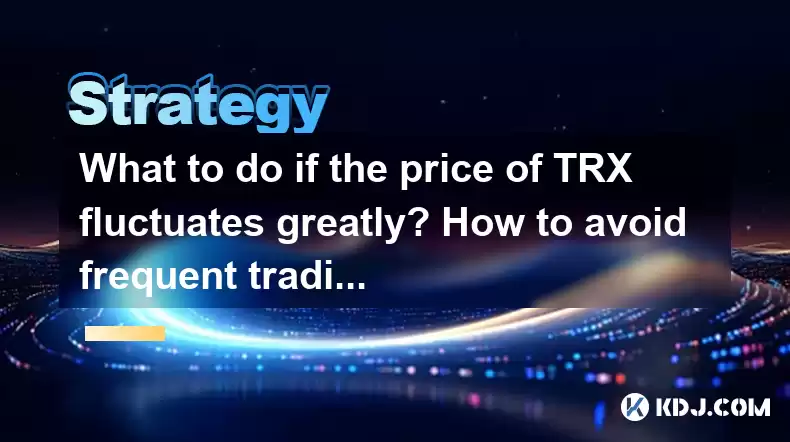-
 Bitcoin
Bitcoin $114400
1.32% -
 Ethereum
Ethereum $3499
2.20% -
 XRP
XRP $2.922
4.26% -
 Tether USDt
Tether USDt $0.0000
0.03% -
 BNB
BNB $752.6
1.53% -
 Solana
Solana $161.8
1.64% -
 USDC
USDC $0.9999
0.01% -
 TRON
TRON $0.3267
1.32% -
 Dogecoin
Dogecoin $0.1991
3.02% -
 Cardano
Cardano $0.7251
3.29% -
 Hyperliquid
Hyperliquid $38.32
3.36% -
 Stellar
Stellar $0.3972
7.58% -
 Sui
Sui $3.437
2.74% -
 Chainlink
Chainlink $16.29
3.65% -
 Bitcoin Cash
Bitcoin Cash $545.3
3.70% -
 Hedera
Hedera $0.2482
7.49% -
 Ethena USDe
Ethena USDe $1.001
0.03% -
 Avalanche
Avalanche $21.40
2.02% -
 Toncoin
Toncoin $3.579
1.56% -
 Litecoin
Litecoin $109.3
2.20% -
 UNUS SED LEO
UNUS SED LEO $8.951
-0.18% -
 Shiba Inu
Shiba Inu $0.00001220
2.75% -
 Polkadot
Polkadot $3.613
2.99% -
 Uniswap
Uniswap $9.173
3.78% -
 Monero
Monero $302.6
2.62% -
 Dai
Dai $0.0000
0.00% -
 Bitget Token
Bitget Token $4.320
1.52% -
 Pepe
Pepe $0.00001048
3.40% -
 Cronos
Cronos $0.1314
4.33% -
 Aave
Aave $259.4
3.54%
What to do if the price of TRX fluctuates greatly? How to avoid frequent trading?
To manage TRX volatility, set clear investment goals, use risk management strategies like stop-loss orders, and avoid frequent trading by sticking to a disciplined plan.
Apr 29, 2025 at 06:15 am

The cryptocurrency market is known for its volatility, and TRX (Tron) is no exception. When the price of TRX fluctuates greatly, it can be challenging to navigate the market without succumbing to the urge to trade frequently. This article will explore strategies to manage the volatility of TRX and avoid the pitfalls of frequent trading.
Understanding TRX Volatility
Volatility in the context of cryptocurrencies like TRX refers to the rapid and significant price changes that occur over short periods. These fluctuations can be driven by various factors, including market sentiment, regulatory news, and broader economic trends. Understanding the nature of volatility is crucial for any TRX investor.
To effectively manage TRX volatility, it is essential to stay informed about the factors that influence its price. This includes monitoring news related to Tron's developments, partnerships, and any regulatory changes that might affect the cryptocurrency market as a whole. By keeping an eye on these factors, you can better anticipate potential price movements and make more informed decisions.
Setting Clear Investment Goals
Before diving into the strategies for managing TRX volatility, it's important to establish clear investment goals. Are you looking for short-term gains, or are you more interested in long-term growth? Your goals will significantly influence your approach to dealing with price fluctuations.
For long-term investors, the focus should be on holding through volatility. This means not reacting to every price swing but instead maintaining a long-term perspective. Long-term investors often use a strategy known as dollar-cost averaging, which involves investing a fixed amount of money at regular intervals, regardless of the price. This approach can help mitigate the impact of volatility over time.
Implementing a Risk Management Strategy
A risk management strategy is vital for navigating the volatility of TRX. One effective method is to set stop-loss orders. A stop-loss order is an order placed with a broker to buy or sell once the stock reaches a certain price. By setting a stop-loss, you can limit potential losses if the price of TRX drops significantly.
- Choose a stop-loss level that aligns with your risk tolerance. For example, if you're willing to risk a 10% drop, set your stop-loss at 10% below your purchase price.
- Monitor and adjust your stop-loss orders as needed. As the price of TRX moves, you might want to adjust your stop-loss to lock in profits or reduce potential losses.
Another aspect of risk management is diversification. Instead of putting all your funds into TRX, consider spreading your investments across different cryptocurrencies. This can help reduce the impact of TRX's volatility on your overall portfolio.
Avoiding Frequent Trading
Frequent trading can be tempting when the price of TRX is fluctuating wildly, but it often leads to increased transaction costs and potential losses. To avoid this, consider the following strategies:
- Set trading rules: Establish clear rules for when you will buy or sell TRX. This could include specific price targets or technical indicators that signal a good entry or exit point.
- Use a trading journal: Keep a record of your trades, including the reasons for entering and exiting positions. Reviewing your journal can help you identify patterns and improve your trading strategy over time.
- Limit exposure to market noise: Constant exposure to market news and social media can lead to impulsive trading decisions. Set specific times to check market updates rather than monitoring them continuously.
Utilizing Technical Analysis
Technical analysis can be a valuable tool for managing TRX volatility and avoiding frequent trading. This involves analyzing historical price data and using various indicators to predict future price movements.
Some common technical indicators used in cryptocurrency trading include:
- Moving Averages: These help smooth out price data to identify trends over time. For example, a 50-day moving average can help you see the overall trend of TRX's price.
- Relative Strength Index (RSI): This indicator measures the speed and change of price movements. An RSI above 70 might indicate that TRX is overbought, while an RSI below 30 might suggest it's oversold.
- Bollinger Bands: These bands can help identify periods of high and low volatility. When the bands widen, it suggests increased volatility, and when they narrow, it indicates lower volatility.
By using these indicators, you can make more informed decisions about when to buy or sell TRX, reducing the need for frequent trading.
Emotional Discipline and Patience
Emotional discipline is perhaps the most critical aspect of managing TRX volatility and avoiding frequent trading. The fear of missing out (FOMO) and the fear of losing money can drive impulsive decisions that are detrimental to your investment strategy.
To maintain emotional discipline:
- Stick to your plan: Once you have established your investment goals and strategies, stick to them. Don't let short-term price movements sway you from your long-term objectives.
- Take breaks: If the market's volatility is causing stress, take a break from trading. Step away from your screens and return with a clearer mind.
- Seek support: Engage with a community of like-minded investors. Sharing experiences and strategies can help reinforce your commitment to a disciplined approach.
Frequently Asked Questions
Q: Can I use automated trading bots to manage TRX volatility?
A: Yes, automated trading bots can be used to manage TRX volatility. These bots can execute trades based on predefined criteria, which can help reduce the emotional aspect of trading. However, it's essential to thoroughly test and monitor any bot to ensure it aligns with your investment strategy.
Q: How often should I review my TRX investment strategy?
A: It's a good practice to review your TRX investment strategy at least quarterly. This allows you to assess the performance of your investments and make any necessary adjustments based on changes in the market or your personal financial situation.
Q: Are there any specific tools or platforms recommended for tracking TRX price movements?
A: Several tools and platforms can help you track TRX price movements. Some popular options include CoinGecko, CoinMarketCap, and TradingView. These platforms offer real-time price data, historical charts, and various technical indicators to aid in your analysis.
Q: How can I stay updated on Tron's developments and news?
A: To stay updated on Tron's developments, you can follow their official social media channels, such as Twitter and Telegram. Additionally, subscribing to cryptocurrency news websites like CryptoSlate or CoinDesk can provide you with timely updates on TRX and the broader cryptocurrency market.
Disclaimer:info@kdj.com
The information provided is not trading advice. kdj.com does not assume any responsibility for any investments made based on the information provided in this article. Cryptocurrencies are highly volatile and it is highly recommended that you invest with caution after thorough research!
If you believe that the content used on this website infringes your copyright, please contact us immediately (info@kdj.com) and we will delete it promptly.
- Kaspa, HBAR, and Cold Wallet: A New York Minute on Crypto's Latest Moves
- 2025-08-04 09:11:54
- Ethereum Whale Watch: Selling Pressure and Price Volatility
- 2025-08-04 09:11:54
- XRP ETF Mania: Teucrium's Crypto Triumph and the Altcoin Frenzy
- 2025-08-04 09:30:13
- Crypto Wallet Scam: A $900K Loss & What You Need to Know
- 2025-08-04 09:35:13
- Dogecoin's Wild Ride: Elliott Wave, Stochastic RSI, and What's Next, Ya Know?
- 2025-08-04 09:40:12
- Shiba Inu (SHIB), Crypto Investments, and the Meme Coin Evolution: What's the Deal?
- 2025-08-04 09:45:17
Related knowledge

How to avoid common crypto investment mistakes?
Jul 13,2025 at 01:35am
Understanding the Risks of Crypto InvestmentInvesting in cryptocurrency can be highly rewarding, but it also comes with significant risks. One of the ...

What is a long-short crypto strategy?
Jul 15,2025 at 10:56am
Understanding the Basics of a Long-Short Crypto StrategyA long-short crypto strategy is an investment approach where traders simultaneously take long ...

What is a long-short crypto strategy?
Jul 11,2025 at 01:28pm
Understanding the Basics of Long-Short Crypto StrategyA long-short crypto strategy is an investment approach where traders take both long and short po...

How to use the RSI indicator for crypto?
Jul 12,2025 at 03:56pm
Understanding the RSI Indicator in Cryptocurrency TradingThe Relative Strength Index (RSI) is a momentum oscillator used to measure the speed and chan...

Is copy trading a good strategy for crypto beginners?
Jul 12,2025 at 08:28am
Understanding Copy Trading in the Cryptocurrency MarketCopy trading is a strategy where novice traders replicate the trades of experienced investors a...

How to build a crypto portfolio with $1000?
Jul 13,2025 at 08:14pm
Understanding the Basics of Cryptocurrency InvestmentBuilding a crypto portfolio with $1000 starts with understanding the fundamentals of cryptocurren...

How to avoid common crypto investment mistakes?
Jul 13,2025 at 01:35am
Understanding the Risks of Crypto InvestmentInvesting in cryptocurrency can be highly rewarding, but it also comes with significant risks. One of the ...

What is a long-short crypto strategy?
Jul 15,2025 at 10:56am
Understanding the Basics of a Long-Short Crypto StrategyA long-short crypto strategy is an investment approach where traders simultaneously take long ...

What is a long-short crypto strategy?
Jul 11,2025 at 01:28pm
Understanding the Basics of Long-Short Crypto StrategyA long-short crypto strategy is an investment approach where traders take both long and short po...

How to use the RSI indicator for crypto?
Jul 12,2025 at 03:56pm
Understanding the RSI Indicator in Cryptocurrency TradingThe Relative Strength Index (RSI) is a momentum oscillator used to measure the speed and chan...

Is copy trading a good strategy for crypto beginners?
Jul 12,2025 at 08:28am
Understanding Copy Trading in the Cryptocurrency MarketCopy trading is a strategy where novice traders replicate the trades of experienced investors a...

How to build a crypto portfolio with $1000?
Jul 13,2025 at 08:14pm
Understanding the Basics of Cryptocurrency InvestmentBuilding a crypto portfolio with $1000 starts with understanding the fundamentals of cryptocurren...
See all articles

























































































